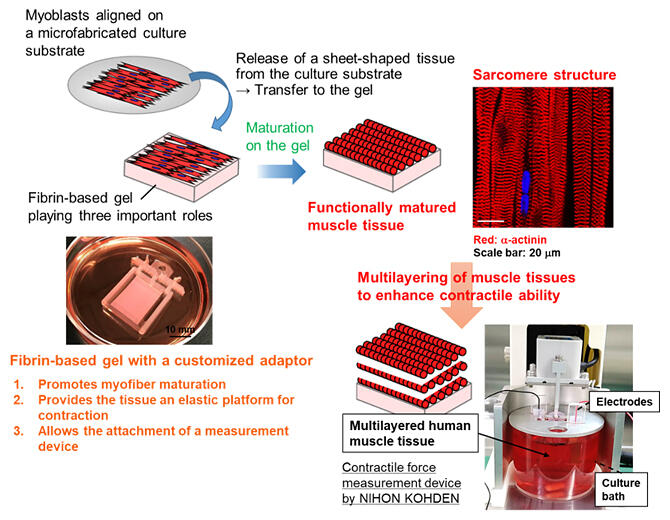A group led by Assistant Professor Hironobu Takahashi and Professor Tatsuya Shimizu of the Institute of Advanced Biomedical Engineering and Science, Tokyo Women's Medical University, in collaboration with a research group led by Associate Professor Kenichi Nagase of the Faculty of Pharmacy, Keio University, has developed a technology to produce a human skeletal muscle tissue model with high contractile force. Furthermore, by combining this with a system that can quantitatively measure contractile force, they developed a technique that enables the effects of specific drugs on muscles to be deciphered from changes in contractile force.

Provided by Tokyo Women's Medical University
Although the technology for regenerating biological tissue has advanced dramatically, it is still not easy to grow human muscle tissue to a sufficient level in vitro. Since muscle cannot be used as a tissue model without its most important ability, contraction, it was necessary to find a special culture technique that promotes muscle growth. It is also essential to focus on efficiently improving the function of the tissue, as high contractility makes it more accurate as a tissue model.
By developing a special culture substrate, the research group was able to produce sheet‐like muscle tissue consisting of myofibers oriented in the same way as in living organisms and used this as the basis for the construction of a human muscle tissue model useful in the study of muscle diseases. They were able to create strong muscle tissue by multilayering the sheet tissue, demonstrating that it can be used as a tool to understand the effects of drugs.
This multi‐layered muscle tissue can produce sufficiently high contractile force that can be quantitatively measured, thus producing strong human muscle tissue. Furthermore, this muscle tissue has been devised to be applicable to the contraction force measurement device, developed by Nihon Kohden Corporation, by employing a technique using fibrin gel, which is also a physically flexible material with a high affinity for cells. As a result, it is now possible to measure the muscle contractions produced by electrical stimulation of muscle tissue.
The researchers demonstrated that this muscle tissue modelling system can be used to monitor the effects of drugs on muscles in real time.
"In order to find effective drugs for muscle diseases for which there is still no fundamental treatment, we believe it is important to quickly visualize the effects of drugs that could not be seen in animal experiments by using highly accurate human muscle tissue models," explained Takahashi. "The system we developed will lead to technology for reproducing muscle diseases as tissue models and quantitatively evaluating their behavior, so we expect to be able to evaluate the action of new drugs in human muscle from the initial stages."
Journal Information
Publication: Small Methods
Title: Engineered human muscle tissue from multilayered aligned myofiber sheets for studies of muscle physiology and predicting drug response
DOI: 10.1002/smtd.202200849
This article has been translated by JST with permission from The Science News Ltd. (https://sci-news.co.jp/). Unauthorized reproduction of the article and photographs is prohibited.




